27 Fascinating & Fun Hawk Facts You Never Knew
Last Updated on
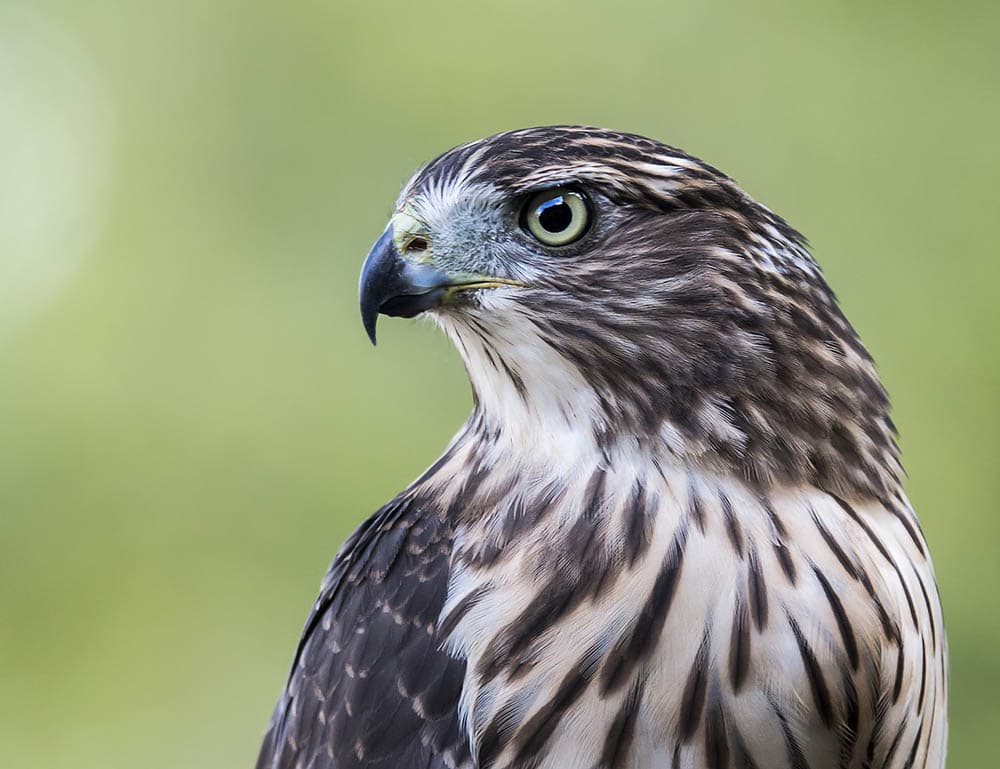
Today, we’re going to learn about a species that’s capable of spotting prey from a mile away. One that’s feared and respected in equal measure, not because it’s one of the biggest animals in the animal kingdom, but simply because its hunting prowess is unrivalled.
The following are some of the fascinating hawk facts that left us in awe!

The 27 Most Interesting Facts About Hawks
1. There are more than 200 hawk species on this planet.
We don’t know if you’ve realized this, but some birds come in countless species, while others only have a handful. And we think the reason behind this is the fact that nature seems to favor some over others.
These birds didn’t just have different species and subspecies come out of nowhere. They evolved over time, consequently developing features and behavior that was so different from the original species.
Charles Darwin’s theory of natural selection explains it all — only the strongest survive, and they do so through evolution.
The hawk happens to be one of those species we’re talking about. It’s one of the few birds that can be found anywhere in the world, because it knows how to adapt to gradual changes in the environment.

2. In the United States, you’ll only be able to find 25 hawk species.
We used to have less, but now we have 25 confirmed hawk species in our country. The Cooper’s hawk, Carne hawk, Red-tailed hawk, Northern Harrier, Zone-tailed hawk, Common Black hawk, Gray hawk, Northern Goshawk, Great Black hawk, White-tailed hawk, Sharp-shinned hawk, Ferruginous hawk, Broad-winged hawk, Red-shouldered hawk, Roadside hawk, Swainson’s hawk, Rough-legged hawk, Short-tailed hawk, and Harris’s hawk, are all common species that have been sighted in the United States.
These hawks can survive in different habitats, as they can all be found building homes in wet areas, or conifers.
3. The red-tailed hawk is the most common hawk in North America.
Even though hawks are known to not care about how harsh the conditions of a particular habitat are, researchers realized that they tend to avoid urban settlements. But this isn’t the case with the red-tailed hawk.
Once it establishes that food is in abundance in a certain area, not even its dense human population will keep the bird at bay. That’s one of the reasons why it’s easy to spot one.
The second reason is a case of “One man’s meat is another’s poison.”
So everybody knows by now that we’ve lost so many species to extinction due to alterations made to their habitats. Funny thing is, it seems like those same alterations are the reason why the red-tailed hawk population has drastically increased.
Just look at logging and forest fires, for example. The amount of destruction caused by these two is insurmountable to say the least, but the Red-tailed hawk has benefited in that they have opened up habitats that were previously wooden and not conducive hunting grounds.

4. In North America, the Sparrowhawk is the smallest.
Conservationists will confirm that although the Sparrowhawk is one of the most common hawk species in the world now, it was almost facing extinction a few years back. Some people think it was all due to persecution, but we’re certain that they were being affected by a particular pesticide used in agriculture.
The chemicals used in the production of that pesticide had a thinning effect on their eggs, causing them to break during incubation.
We, however, don’t know if we should celebrate the increased Sparrow population or not, given that they are currently listed as the number one cause of the rapid decline in the songbird’s population.
5. The Ferruginous Hawk is the largest Buteo.
This is undisputable considering it has a wingspan that ranges from 48 to 60 inches, complementing its 20-to-27-inch length. And they are unique in comparison to other hawks in that the females and males are almost the same size. This is unlike other species where we see the females grow to become bigger than their male counterparts.
It’s easier to find a Ferruginous hawk in an open field than anywhere else. Just concentrate in areas characterized by semiarid grasslands, and you might be lucky.
Also, because they are apex predators, they always feel comfortable building nests on the ground. No sane animal would dare intrude such a beast.

6. In the US, the Red-tailed hawk is the largest hawk species.
The Ferruginous might have the title of the largest hawk species in the world, but the Red-tailed hawk is still king in this country. The bird has a wingspan of approximately four feet, and measures 18 to 26 inches in length. You cannot miss it when it’s all stretched out in the sky hunting.
7. The Peregrine Falcon is ridiculously fast.
Sometimes referred to as the Duck hawk, the Peregrine Falcon has a diving speed that’s approximated to be more than 186 miles per hour. That means it might not just be the fastest bird on the planet, but also the fastest animal to ever exist.
And that’s not all, as we also learned that it’s the most widely distributed raptor, with breeding populations everywhere save for the oceanic islands and Antarctica.
Related Read: 12 Fascinating & Fun Falcon Facts You Never Knew
8. Hawks cannot survive in Antarctica.
We started off this piece by talking about how great hawks are at adapting to changes in new environments, and we meant it. Sadly though, the climate in Antarctica is still undefeated. That place is too cold for any bird of prey to survive, and that’s why there’s no single raptor species found there.
The role played by these avian predators in our ecosystems have been taken over by the Brown Skua. They practically eat anything, to ensure their ecosystems remain in balance.
9. Hawks are sometimes referred to as buzzards.
When the colonists got to America, they noticed large birds soaring up in the sky while preying on small animals below. They weren’t quite sure what those birds were, but they realized their flight patterns were so like those of the buzzard — also known as the vulture.
Long story short, that’s how the name “buzzard” came to be.
10. Hawks are carnivores.
So, a carnivore is scientifically described as anything that prefers eating the flesh of another animal or meat. They can sometimes eat plants as well, or insects.
Hawks fall into this category because they essentially eat everything ‘meaty’. You’ll find them eating snakes, amphibians, insects, fish, mammals, and even other birds. Good thing is, their feeding habits have helped us control rodent populations, which could easily turn into pests that spread different diseases.
11. Most hawks build nests off the ground.
Providing shelter and warmth for the eggs being laid is not the only purpose of a nest, in case you were wondering. Safety is also a factor considered while building these structures.
No bird would wish to lay eggs or even care for them in a place that’s easily accessible to predators. They’ll look for a spot that has a clear line of sight, and far from anything that wishes to damage their eggs or harm their babies.
That’s why most hawks build nests high up in places where most predators can’t reach.
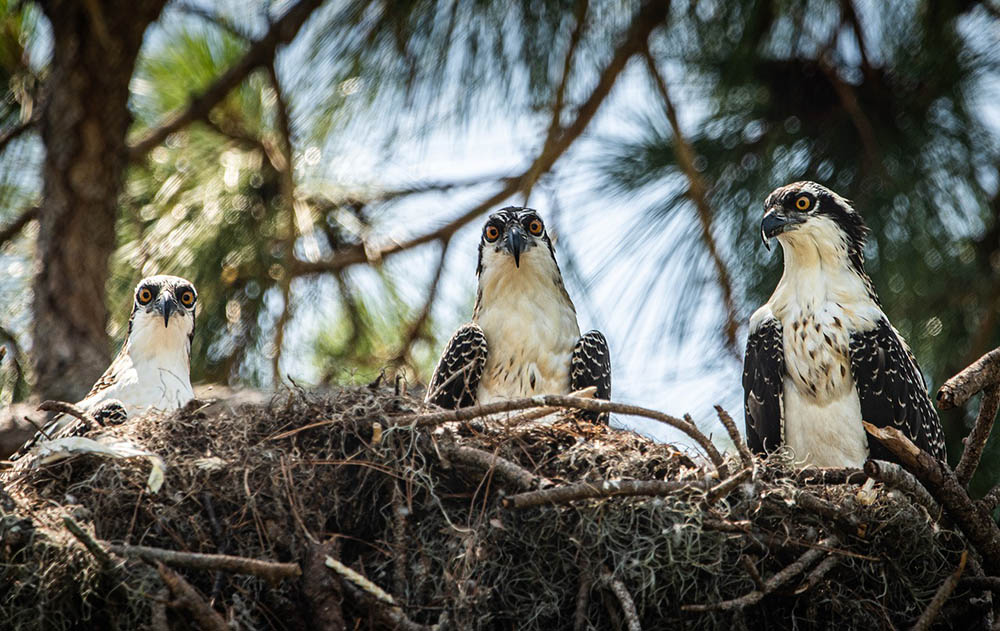
12. Hawks can live for more than 20 years.
These are the stages of growth and development in the hawk community:
Stage 1 involves laying eggs, and the time taken to hatch ordinarily hinges on several environmental factors. But irrespective of the species, it could take anywhere from 28 to 35 days.
Stage 2 is the fledgling stage. This is where they’ll completely rely on their parents to feed and provide care and protection. They cannot really do much since they don’t know how to fly, and even if they did, they still can’t see clearly. By the way, nestlings are always born blind.
After 50 days, they’ll move on to stage 3, known as the juvenile stage. We believe this is the stage where they are most vulnerable because they must learn how to take care of themselves, and fly. Most of them don’t make it past this stage.
36 months later, they’ll move on to the final stage, which is “Adulthood”. At this stage, they are skilled hunters and feared in every ecosystem. They also know how to detect danger lurking in the shadows, and how to protect themselves.
13. Hawks are diurnal creatures.
Nobody should even try to convince you that hawks are chiefly active at night because they aren’t. These birds of prey have been confirmed to be diurnal animals, meaning they’ll only hunt in broad daylight.
You should also know that hawks have one of the best visions in the animal kingdom. Nevertheless, those eyes aren’t as useful under the cover of darkness, as they are during daytime. Just to put it all into context, scientists argue that their vision is eight times sharper than ours.
Apart from their strong bills and deadly talons, they also heavily depend on their sense of sight while hunting for food. So, you can now see why it would be impossible to go out hunting knowing very well they won’t be able to see much.
For the record, hunting around dusk and hunting at night are two very different things. We feel obligated to make this clarification because we know certain species —like the red-tailed hawk, for instance — prefer going out to play around dusk.
There will always be a little bit of sunlight seeping through during dusk, and that’s what they rely on. Plus, that little light works in their favor seeing as it makes their movements less detectable.
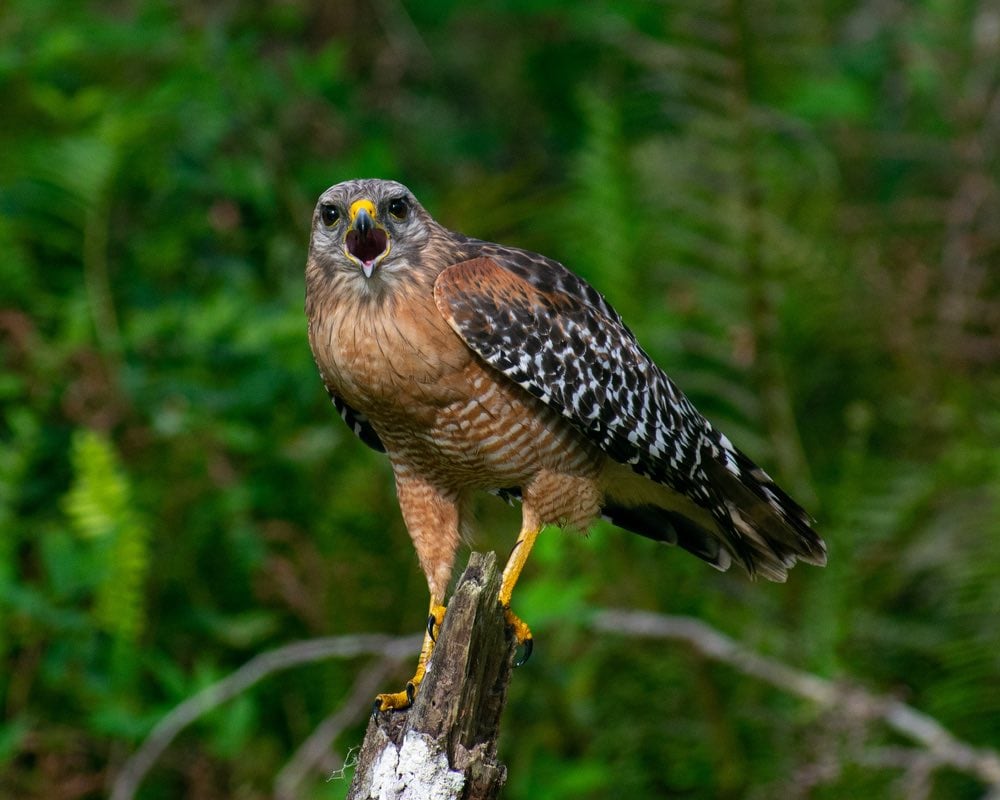
14. The maximum weight a hawk can lift is 5 pounds.
We know you’ve probably heard of a few urban legends that talk about how hawks keep stealing kids, and even pets that weigh more than 10 pounds. Well, we assure you that all those myths are indeed… myths.
The truth is, there’s no bird of prey out there that can fly with something that outweighs it. But if your cat or dog weighs 5 pounds or less, you should consider taking precautions.
15. Every year, the female hawk will lay 2 to 5 eggs.
The total number of eggs will depend on a couple of factors. First off, is the habitat conducive for breeding? Secondly, are the food sources unlimited? Thirdly, how old is the bird? Fourthly, how healthy are the birds? And lastly, what type of hawk species are we looking at?
All these are things to take into consideration while trying to figure out the total number of eggs that a particular hawk species is likely to lay per breeding season.
16. Hawks are territorial in nature.
Their territorial tendencies are meant to ensure that there’s exclusivity in the use of space. These species are cognizant of the fact that if they don’t find a way to mark their territories, they’ll one day go out hunting, only to come back home and find all their resources consumed. Or worse, a conspecific had sneaky copulations with their lifetime mate.
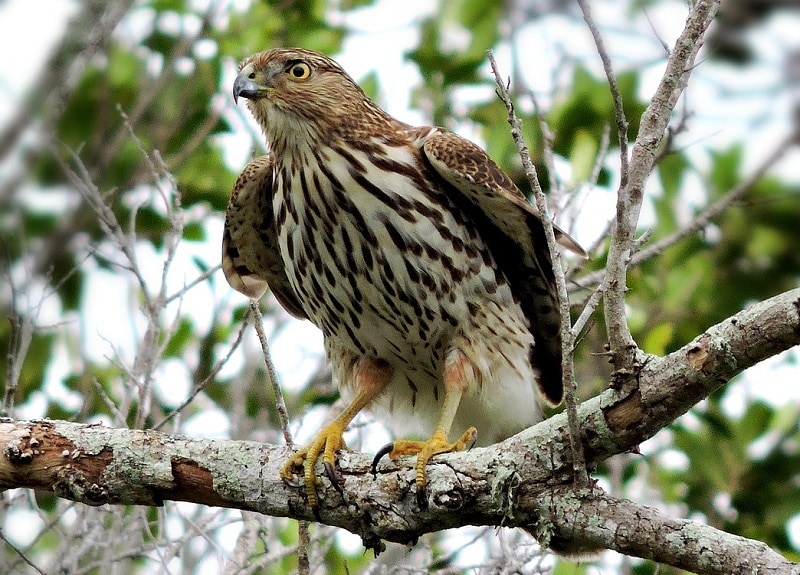
17. Sometimes the hawk will lay a second clutch.
The only time you’ll see a female hawk lay a second clutch of eggs is when the first lot is damaged. And it has to be every egg in that nest. If she suspects that there’s still one that’s good, she’ll incubate it until it’s ready to hatch.
18. “Kettle” is the name used to refer to a group of Hawks.
Hawks like to take advantage of thermals when they are looking to conserve energy. And the sight that they’ll create while they are up there swirling will make you reminisce about the ingredients floating in a pot filled with broth. That’s how the phrase “hawk kettling” was coined.
19. Hawks love solitude.
If you see them together, they are either stalking a prey, or mating. And if they are mating, that pair will be inseparable. They’ll stay together until the babies are strong enough to move on and look for a different territory.
20. They all communicate using four different vocalizations.
Hawks do produce different sounds while communicating with conspecifics. There are times when they’ll screech, hoot, growl, or just scream. All these sounds don’t really mean much to us, but they are very important to the bird. Without them, they’ll never be able to tell who’s a friend or who’s a foe.
If a hawk lets out a scream, it’s either looking for prey, or fighting to defend its territory. Growls are only common during courtship, when the male hawk is doing the usual to impress a female.
A screech is a sign the hawk is pissed off or feels threatened, while a hoot is used during their daily interactions.
21. The force exerted by the talons of the red-tailed hawk is incredible.
Conservationists have reiterated on so many occasions how hawks can kill prey just by grabbing them. In fact, by the time it uses its sharp talons and bill to dissect the prey, it will be long gone.
They don’t even have to use their sharp claws or bill, if they don’t want to. Look at the red-tailed hawk, for example. Its talons can exert an upward pressure of 200 pounds per square inch (psi), thereby instantly killing whatever it grabs.
22. The babies are called Eyas.
In the birding community, “Eyas” is the word we use to refer to the babies of a hawk. And it applies to hawks of any kind. The word was borrowed from the French, translating to “Nestling.”
23. Hawks can fly for thousands of miles.
Every year, you’ll see a kettle of hawks preparing themselves for a journey of sorts. This is usually during spring or fall, a time when the weather conditions aren’t too harsh for anyone looking to travel. The distance they end up covering will depend on the hawk species, but mostly on the availability of food.
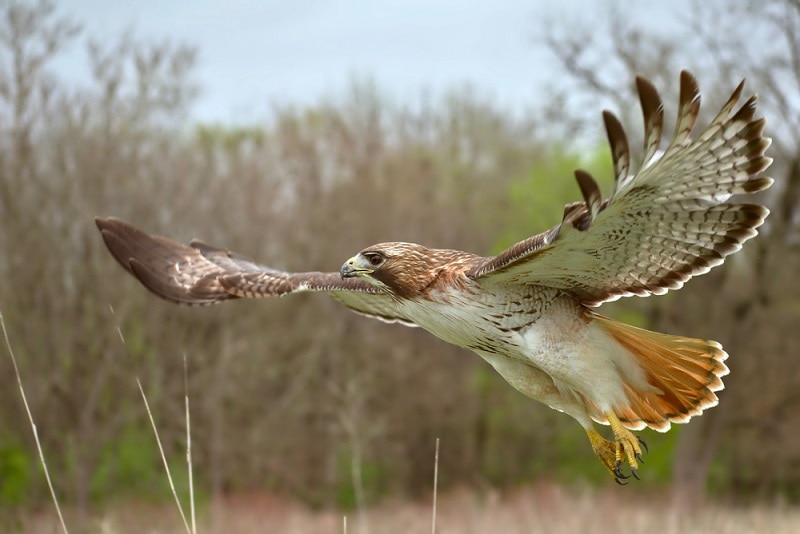
24. The males have a courtship dance.
Getting the attention of a female hawk isn’t easy, and the male hawk knows this. Therefore, he will have to perform a sky-dance.
He’ll leave the female perched on a branch and fly up to high altitudes at crazy speeds. We don’t know how far they go, but he’ll reach a point where he’ll start calling the female to see if she likes what he’s doing. If she does, she’ll respond with a different call, and fly up to join him.
25. A hawk will regurgitate anything indigestible.
Hawks love eating flesh, minus the bones, fur, and feathers. So, if they accidentally eat some, they’ll wait for about an hour, and then regurgitate the pellet.
26. They see ultraviolet light.
This is a discovery that was made when researchers started wondering how hawks tracked their prey. Apparently, their eyes are set up in such a way that they can easily detect UV in urine left behind by rodents. And that’s to this ability, they can quietly follow that trail all the way to the place where the prey’s hiding.
27. The hawk species has different hunting styles.
Hunting comes naturally to the hawk. And it doesn’t quite matter what species we’re talking about because they all have effective and efficient hunting strategies.
The most common strategy is what we call the High Soaring. You’ll see the bird soar around on thermal, as though it’s just having fun, and not interested in what everybody else is doing. But in reality, it’s just waiting for an “opportunity” to present itself.
This strategy is mostly employed by large hawk species that are very good at soaring. It enables them to cover lots of distance, without having to worry about the amount of energy that they’re utilizing.
The other hunting style is the Low Soaring. It is way different from the one we’ve just talked about in that it’s only applicable in fields, meadows, or any other open habitat that you could think of. Hawk species that are a tad bit smaller than the average size are the ones that make use of this method, as it banks on the surprise element and swift action.
Co-operative hunting is also a thing in the hawk community. It involves working together to catch a prey that looks stronger or bigger than the hawk itself. One hawk will act as a decoy and fly into the area just to cause some sort of panicked flurry of retreat. The others will wait for the prey on the other side, and pounce when it least expects it.
We were shocked to learn that this is something that they do more often than not. And not just one species, but several. We even witnessed the sharp-shinned hawks, red-tailed hawks, cooper’s hawks, and red-shouldered hawks employ this tactic.
Perch and swoop is the only hunting style that doesn’t involve any flying. All the hawk does is sit still on a branch and observe in silence. He or she won’t be in a rush because they’ll know that the whole area has food capable of feeding an entire population and then some. The minute it spots the right prey, it will swoop down and grab it.

Conclusion
We felt like these facts were too cool to keep for ourselves, and that’s why we decided to share them with you guys. So, if you’ve also learned anything new recently that you’d like to share, feel free to reach out.
Featured Image Credit: Pixabay
Table of Contents
- The 27 Most Interesting Facts About Hawks
- 1. There are more than 200 hawk species on this planet.
- 2. In the United States, you’ll only be able to find 25 hawk species.
- 3. The red-tailed hawk is the most common hawk in North America.
- 4. In North America, the Sparrowhawk is the smallest.
- 5. The Ferruginous Hawk is the largest Buteo.
- 6. In the US, the Red-tailed hawk is the largest hawk species.
- 7. The Peregrine Falcon is ridiculously fast.
- 8. Hawks cannot survive in Antarctica.
- 9. Hawks are sometimes referred to as buzzards.
- 10. Hawks are carnivores.
- 11. Most hawks build nests off the ground.
- 12. Hawks can live for more than 20 years.
- 13. Hawks are diurnal creatures.
- 14. The maximum weight a hawk can lift is 5 pounds.
- 15. Every year, the female hawk will lay 2 to 5 eggs.
- 16. Hawks are territorial in nature.
- 17. Sometimes the hawk will lay a second clutch.
- 18. “Kettle” is the name used to refer to a group of Hawks.
- 19. Hawks love solitude.
- 20. They all communicate using four different vocalizations.
- 21. The force exerted by the talons of the red-tailed hawk is incredible.
- 22. The babies are called Eyas.
- 23. Hawks can fly for thousands of miles.
- 24. The males have a courtship dance.
- 25. A hawk will regurgitate anything indigestible.
- 26. They see ultraviolet light.
- 27. The hawk species has different hunting styles.
- Conclusion
About the Author Robert Sparks
Robert’s obsession with all things optical started early in life, when his optician father would bring home prototypes for Robert to play with. Nowadays, Robert is dedicated to helping others find the right optics for their needs. His hobbies include astronomy, astrophysics, and model building. Originally from Newark, NJ, he resides in Santa Fe, New Mexico, where the nighttime skies are filled with glittering stars.
Related Articles:
How to Clean a Refractor Telescope: Step-by-Step Guide
How to Clean a Telescope Eyepiece: Step-by-Step Guide
How to Clean a Rifle Scope: 8 Expert Tips
Monocular vs Telescope: Differences Explained (With Pictures)
What Is a Monocular Used For? 8 Common Functions
How to Clean a Telescope Mirror: 8 Expert Tips
Brightfield vs Phase Contrast Microscopy: The Differences Explained
SkyCamHD Drone Review: Pros, Cons, FAQ, & Verdict
